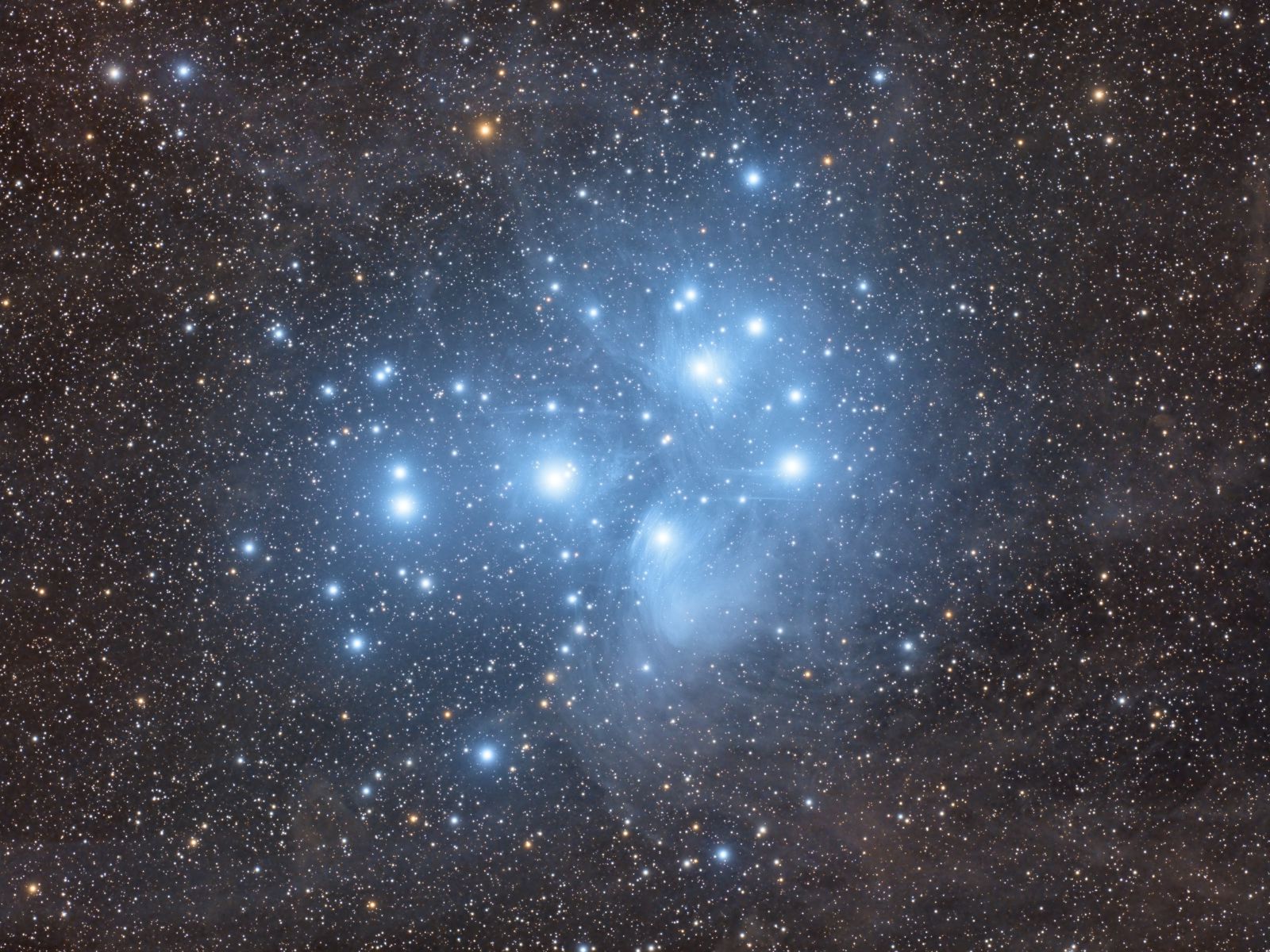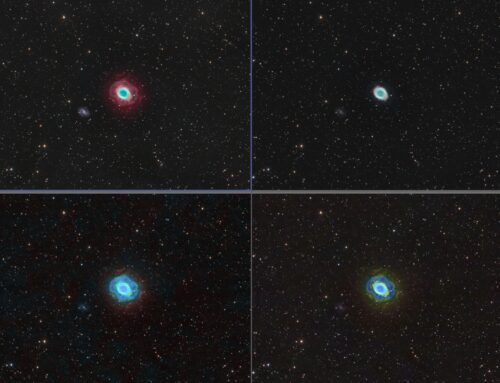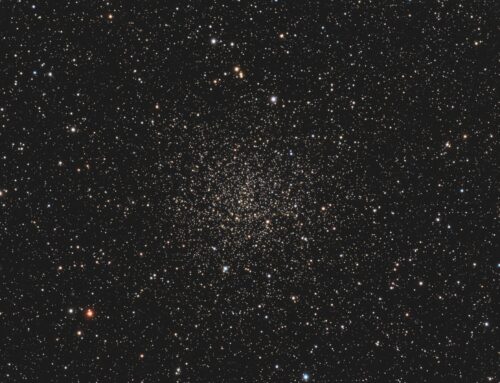M45 (2021)
Click image for full size version
February 21, 2021
M45 is better known as the Pleiades, or the Seven Sisters. In Latin America, it’s called “the Seven Kids”, referring to baby goats. It is one of the objects that I image with every setup, because it is bright, beautiful, and a real challenge to process.
The Pleiades was observed and written about long before Messier catalogued it. Galileo published a sketch in 1610 that showed 36 stars that he could see with his telescope. The earliest known depiction of the Pleiades is from is about 17,000 years old: a cave drawing in the Lascaux Cave in France. If you get a chance, have a look at this object through binoculars. It is spectacular and well placed for imaging in winter in the northern hemisphere.
The blue haze around this star cluster is a reflection nebula – star light is being reflected of soot/dust particles in the background. There’s also some pinkish emission nebula (NGC 1435) in the lower portion of the nebula and dim brownish dust mottling the outer parts of this field (called “cirrus”). M45 is about 440 light years from us and contains at least 1000 members in the cluster. The stars have been estimated to be between 75 and 150 million years old. The brightest cluster stars belong to class B, and are very hot bluish stars.
Although the star cluster and reflection nebula are the dominant objects in this shot, there are also hundreds of galaxies lying far in the background. I have posted an annotated image from 2017 that highlights the location of some of them. In October 2016 I posted a higher resolution image that shows even more galaxies. I’ve also imaged this in a wider field, in 2020.
Tekkies:
Acquisition, focusing, and control of Paramount MX mount (unguided) with TheSkyX. Focus with Optec DirectSync motor and controller. Automation with CCDCommander. Equipment control with PrimaLuce Labs Eagle 3 Pro computer. All pre-processing and processing in PixInsight. Acquired from my SkyShed in Guelph. Average transparency and average seeing. Data acquired December 6, 2020 – February 9, 2020 under a moonless sky.
Takahashi FSQ-106 ED IV @ f/5 and QHY367C Pro one-shot colour camera with Optolong UV/IR filter
Data Reduction and Initial Processing
Preprocessing: The WeightedBatchPreProcessing script was used to create registered files. ImageIntegration followed by DrizzleIntegration (with CFA Drizzle option and scale of 1x) was used to make the colour master. The master was cropped to remove edge artifacts using DynamicCrop.
Gradient Removal: DBE was applied to the master using Subtraction.
Luminance Extraction: RGBWorkingSpace was used to equalize the luminance colour channels prior to extracting CIE L* luminance.
Colour
Colour Balancing: Colour was balanced with ColorCalibration.
Linear Noise Reduction: MultiscaleLinearTransform was used to reduce noise in the background areas, using an internal mask to protect bright structures. Layer settings for threshold and strength: Layer 1: 4.0 0.85, 2 iterations; Layer 2: 3.5, 0.75, 2 iterations.
Stretching: HistogramTransformation was applied to make a pleasing, bright image, with background set to an intensity of approximately 0.15.
Luminance
Deconvolution: A star mask was made to use as a Local Deringing Support image. A copy of the luminance image was stretched to use as a range mask. Deconvolution was applied (30 iterations, regularized Richardson-Lucy, parametric PSF with size of 3).
Linear Noise Reduction: MultiscaleLinearTransform was used to reduce noise in the background areas, using an internal mask to protect bright stars. Layer settings for threshold and strength: Layer 1: 3.0 0.85, 1 iterations; Layer 2: 2.0, 0.75, 2 iterations.
Stretching: HistogramTransformation was applied to make a pleasing, bright image, with background set to an intensity of approximately 0.15.
Combining Lightness and Colour Images
LRGB Combination: The lightness image was applied to the RGB image using LRGBCombination with default settings.
Additional Processing
Nonlinear Noise Reduction: TGVDenoise was used in L*a*b* mode to reduce noise with a mask used to target the background areas and protect the stars (max. 1,000 iterations and convergence selected for both lightness and chrominance).
Contrast Enhancement: LocalHistogramEqualization was applied twice (kernel radius of 20 and 150, each with max contrast 1.5 and amount 0.25).
Sharpening: MultiscaleLinearTransform was used sharpen the lightness using a mask used to target the high signal areas while protecting the stars and the background (bias increased to 0.4 for layer 2 and 0.1 for layer 3).
Final Steps:ExponentialTransformation was applied to boost faint nebulosity using a mask to protect stars and bright regions of the nebula. Background and star brightness, contrast, and colour saturation were adjusted in several iterations using CurvesTransformation with masks as required. ICCProfileTransformation (sRGB IEC61966-2.1; Relative Colorimetric with black point compensation) was applied prior to saving in jpg format.







beautiful image and thank you for your workflow, very helpful. especially the exponential transformation. for some reason i have not think if using more complicated masks on it.
This is fabulous!! In the words of Ron Brecher, “Be true to the light”…Ron is the top of his game…I know personally for sure, being a humble student of his in PixInsight over time…
Thank you Ron for sharing not only another outstanding process of imaging, but sharing the workflow for everyone to admire and take note….!!